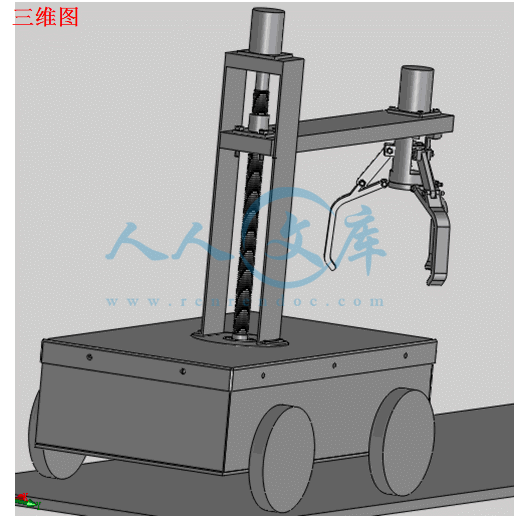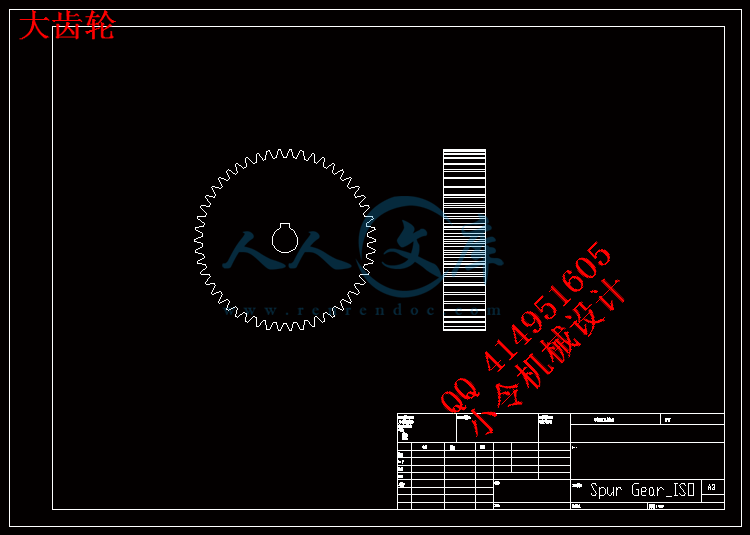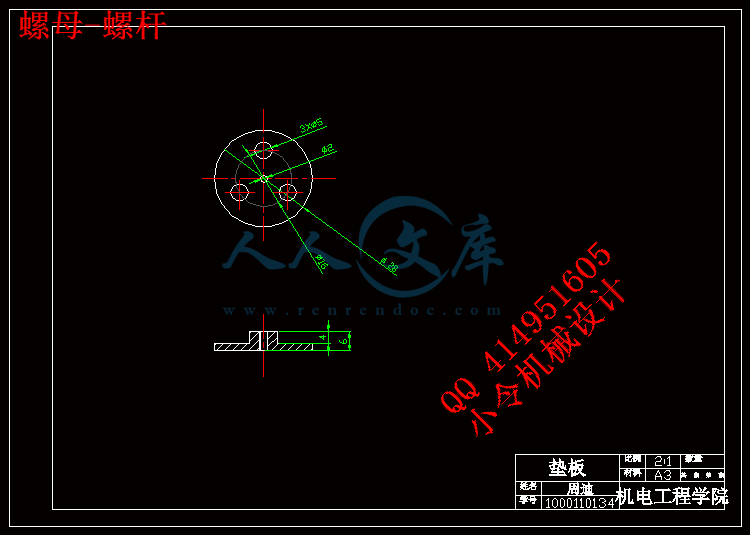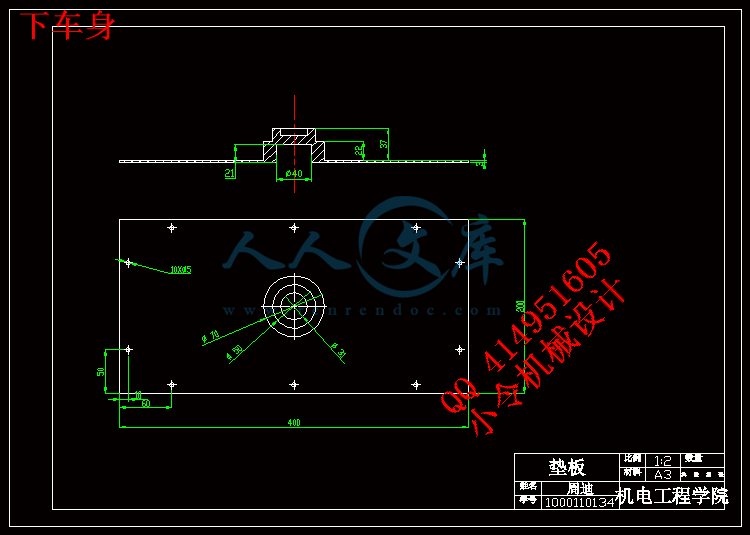【温馨提示】 购买原稿文件请充值后自助下载。
[全部文件] 那张截图中的文件为本资料所有内容,下载后即可获得。
预览截图请勿抄袭,原稿文件完整清晰,无水印,可编辑。
有疑问可以咨询QQ:414951605或1304139763
摘 要
很多地方是我们人类没法进去的,因为其中的一些东西已经对我们造成了生命的威胁,但我们又有必须进去的理由。在这种场合下,机械就能为我们解决这些问题,因为它可以代替我们进行一些危险操作,用来取代人力来工作。我们设计的抓物机器车是在机械化,自动化生产过程中发展起来的一种将机械手和搬运车联系为一体的产品。使其能抓物运动,可以在地形复杂或恶劣、危险的环境里替人完成物体的搬运或者障碍的清除等工作。
抓物机器车的设计主要是通过无线通信来控制小车的前进、后退或者转弯,并由螺杆转动,带动螺杆上的螺母上下移动,再通过连杆结构实现抓爪的闭合,从而实现抓物动作。丝杆竖直放置,转臂固定在丝杆螺母上,步进电机带动丝杆旋转,螺母会上下移动,转臂也会上下移动,也就是机械手上下移动,满足了机械手降下抓物,升高移动物体的情况。机械手的转动,在由齿轮带动固定丝杆的中间件转动而实现的。
关键词:机器车;抓物;丝杆
Abstract
Many things that we humans can not go , because some of these things have been a threat to our life , but the reason we have to go in there . In this case , our machinery will be able to solve these problems. Because it can replace us doing some dangerous operation , to replace manpower to work. Because it can replace us some dangerous operation, to replace manpower to work. We have designed the Grasping machine car that developed in the mechanization and automation of the production process and the robot van combined into one product. So that it can catch things exercise can help people complete the removal of an object or obstacle clearance work in complex terrain or harsh, dangerous environment.
Grasping machine car designed primarily controlled by a wireless communication car forward, backward, or turn. by the screw rotates, driven to move up and down the screw on the nut, and then realize gripper closure through the link structure to realize grasping objects actions . Screw placed vertically, and the arm is fixed on screw nut, stepper motor driven rotary screw, nut meeting next move, the arm will move up and down, which is under the robot moves down to meet the robot grasping objects, elevated movement of the object. Turn the robot, driven by fixed-gear screw rotation middleware
implementation.
Key words: machine car; grasping objects; screw
目 录
引言 1
1 设计方案 2
1.1 设计内容 2
1.2 设计目的 2
1.3 方案的选择 2
2 机械手的设计 3
2.1 抓手结构的设计 3
2.2 爪片的设计 5
2.3 螺杆的设计 7
2.3.1确定螺纹中径 8
2.3.2螺杆的强度计算 9
2.3.3螺母螺纹牙的强度计算 9
2.4 连杆盘的设计 10
2.5 套筒的设计 11
2.5.1套筒的尺寸 11
2.5.2螺栓的选择 11
2.5.3螺纹连接的防松 13
3 转臂的设计 13
3.1 受力分析 13
3.2 转臂的尺寸计算 14
3.3 螺栓的设计 15
3.3.1螺栓组结构设计 15
3.3.2螺栓受力分析 15
4 滑动丝杆的设计 16
4.1 螺纹牙型的选择 16
4.2 螺距选择 16
4.3 丝杆直径的确定 16
4.4 螺杆的强度计算 17
4.5 螺母螺纹牙的强度计算 17
4.6 丝杆的长度 18
4.7 丝杆螺母的传动形式 18
4.8 丝杆的固定 19
4.9 轴承的选择 19
4.10 固定板的设计 21
4.10.1固定板的结构 22
4.10.2固定架的固定 22
5 转盘的设计 23
5.1 中间板的设计 23
5.2 键的选择 25
5.3 齿轮的设计 25
5.3.1选定齿轮类型,精度等级,材料及模数 25
5.3.2按齿面接触疲劳强度设计 26
5.3.3按齿根弯曲疲劳强度设计 27
5.3.4几何尺寸计算 27
5.4 轴的设计 28
6 车身的设计 30
6.1 上车身的设计 30
6.2 下车身的设计 31
6.3 支板的设计 35
6.3.1支板的结构 35
6.3.2尺寸计算 35
6.3.3支板的连接 36
6.3.4轮子孔的设计 36
7 solidworks的建模和仿真 37
8 总结 38
谢 辞 39
参考文献 40
引言
随着社会的进步,社会的分工也越来越细,特别是在现代化的生产中,有的人每天就只能做着同一件事,或者是拧同个部位的某个螺母,或者是接着同一个地方的线头,就像电影《摩登时代》中所演的,由于老是做同一个动作,身体相同的部位得不到休息,于是开始产生了各种职业病。于是人们强烈的希望能有什么东西能代替自己工作而自己不用那么的难受。于是机器人就被发明了出来,并替人完成那些很枯燥、单调、危险的工作。而且,机器人的发明大大的提高了工作效率,提高了工业的发展,为更多的人提供了机会。
机器人的出现,使人们摆脱了那些繁琐、危险的工作。一般的,在有危险,对人体有害的场合,你总能看到他们的身影。如喷漆行业,油漆发出的气味很难闻,那是有毒气体,闻多了会对人体造成难以想象的伤害;还有电焊的场合也是对人眼睛的伤害也很大,也是有了专门用来焊接的机器人。这样的地方很多,在工业里已经屡见不鲜了。特别是在汽车和工程机械行业里,喷漆和焊接那是必不可少的。也正是这些工作对汽车行业的不可或缺,近几年来,国内生产的工业机器人大多是用于服务汽车行业的,也正因为这样,汽车工业的发展也推动了机器人的增长。
在一些对灰尘要求很严的重要场合或者实验室中,一旦灰尘的量超过了标准,就会有废品的出现。例如要在 10级洁净室中制造的电脑重要器件。按国际标准,10级洁净室就是要在一立方英尺内不得出现超过10个以上的直径大于0.5微米的尘埃。100级洁净室就是在一立方英尺内不得出现100个同样大小的尘埃。可就是想进入100级洁净室,工作人员也要换上特制的装备才可以进去,而且,在进去之前的5个小时都不可以使用化妆品或者吸烟等,这条件可见很难做到了。所以10级洁净室也只能由机器来完成了,想进去,条件太苛刻了。
而有些场合,由于被环境的限制,如有放射性物质,被有害气体包围等,我们很难进去,也没法找里面的东西出来研究。于是特制的抓物机器车就很有必要设计出来。
这次设计是基于三维软件Solidworks设计的。该软件的功能很强大,组件也很多。 Solidworks是现在最主流的三维CAD解决方案,因为他具有了功能强大、易学易用、技术创新等特点。 而且SolidWorks可以提供不同的设计方案、减少了设计过程中的错误以便提高产品质量。对工程师和设计者来说,SolidWorks 不仅提供如此强大的功能,操作更是简单方便、易学易用。
1 设计方案
1.1 设计内容
因为是要进行比较精密的抓取物体,所以采用无线通信技术实现对机器车的控制。通过无线接通电机,电机驱动轮子来实现小车的前进、后退与转向。而在小车的上面则是抓物机械手的部件。要实现机械手的上下移动还有一定范围的转动,还有爪片的自由张合。
1.2 设计目的
(1)可以在危险的,无人可进入的地方抓住物体并且移动物体,便于实验和研究。
(2)由于抓物机器车使用无线通信技术控制,其动作准确,操作简单,因此可以提高稳定性能。
1.3 方案的选择
由于小车的移动都要很精确,所以只考虑了步进电机和伺服电机。步进电机的速率是由驱动器信号输入的脉冲数量和频率来控制的。但不适合在长时间和同方向的场合使用,这样容易烧坏电机。而伺服电机与步进电机相比,在控制方式上很相似都是用脉冲串和方向信号,但价格相对来说较高。在性能满足的情况下,考虑经济方面,我们采用了步进电机。
对于机械手的上下移动,可以想到的有液压、气动还有丝杆。考虑液压和气动都比较的便宜,但考虑到精确度,能采用的也只有丝杆了。对于爪片的自由张合,气动便宜实用,但由于在前面都没用到,在这里用的话还得设计气动装置,麻烦而且也不太实际,因此我们采用了步进电机。
2 机械手的设计
由于设计的抓物车一般是在危险的地方工作,那地方可能是一些夹缝什么的,因此我们设计的小车都比较的小。设小车的尺寸为400*200*100mm,而抓取的物体最重为6KG。
2.1 抓手结构的设计
设抓盘的直径为50mm,爪子的开口角度为120度,抓爪可转动30度。采用的是四杆机构来实现爪子的自由张合。结构如图所示:
图2-1 四杆结构简图
其中L1是连杆盘与抓盘的距离,L2是爪子上两个圆柱销之间的距离,L3是连杆与爪子的距离,L4是连杆。
如图,L2、L3、L4为定长,而L1随着连杆盘的移动而改变,当连杆盘向上移动时,L1会变大,那时,连杆L4通过L3拉着L2向上转动,那时爪子张开:相反,当连杆盘向下移动时,连杆会压爪子向下转动,即爪子会抓紧物体。
受力分析:








 川公网安备: 51019002004831号
川公网安备: 51019002004831号